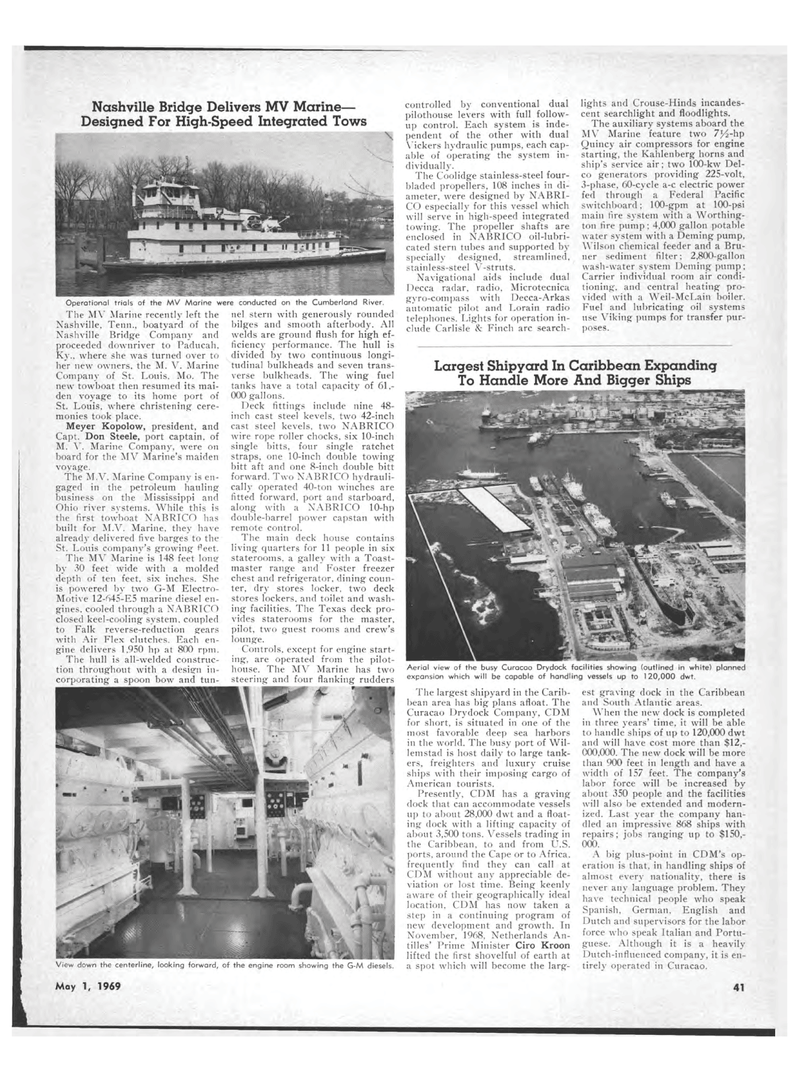
Page 39: of Maritime Reporter Magazine (May 1969)
Read this page in Pdf, Flash or Html5 edition of May 1969 Maritime Reporter Magazine
Nashville Bridge Delivers MV Marine? Designed For High-Speed Integrated Tows ?it . '' ' . A-i. _ . * ... & . ' \ Operational trials of the MV Marine \ The MV Marine recently left the Nashville. Tenn., boatyard of the Nashville Bridge Company and proceeded downriver to Paducah. Ky.. where she was turned over to her new owners, the M. V. Marine Company of St. Louis. Mo. The new towboat then resumed its mai-den voyage to its home port of St. Louis, where christening cere-monies took place. Meyer Kopolow, president, and Capt. Don Steele, port captain, of M. V. Marine Company, were on board for the MV Marine's maiden voyage. The M.V. Marine Company is en-gaged in the petroleum hauling business on the Mississippi and Ohio river systems. While this is the first towboat NABRICO has built for M.V. Marine, they have already delivered five barges to the St. Louis company's growing feet. The MV Marine is 148 feet long-by 30 feet wide with a molded depth of ten feet, six inches. She is powered by two G-M Electro-Motive 12-645-E5 marine diesel en-gines. cooled through a NABRICO closed keel-cooling system, coupled to Falk reverse-reduction gears with Air Flex clutches. Each en-gine delivers 1,950 hp at 800 rpm. The hull is all-welded construc-tion throughout with a design in-corporating a spoon bow and tun-e conducted on the Cumberland River, nel stern with generously rounded bilges and smooth afterbody. All welds are ground flush for high ef-ficiency performance. The hull is divided by two continuous longi-tudinal bulkheads and seven trans-verse bulkheads. The wing fuel tanks have a total capacity of 61,-000 gallons. Deck fittings include nine 48-inch cast steel kevels, two 42-inch cast steel kevels, two NABRICO wire rope roller chocks, six 10-inch single bitts, four single ratchet straps, one 10-inch double towing bitt aft and one 8-inch double bitt forward. Two NABRICO hydrauli-cally operated 40-ton winches are fitted forward, port and starboard, along with a NABRICO 10-hp double-barrel power capstan with remote control. The main deck house contains living quarters for 11 people in six staterooms, a galley with a Toast-master range and Foster freezer chest and refrigerator, dining coun-ter, dry stores locker, two deck stores lockers, and toilet and wash-ing facilities. The Texas deck pro-vides staterooms for the master, pilot, two guest rooms and crew's lounge. Controls, except for engine start-ing, are operated from the pilot-house. The MV Marine has two steering and four flanking rudders View down the centerline, looking forward, of the engine room showing the G-M diesels. May 1, 1969 controlled by conventional dual pilothouse levers with full follow-up control. Each system is inde-pendent of the other with dual Vickers hydraulic pumps, each cap-able of operating the system in-dividually. The Coolidge stainless-steel four-bladecl propellers, 108 inches in di-ameter, were designed by NABRI-CO especially for this vessel which will serve in high-speed integrated towing. The propeller shafts are enclosed in NABRICO oil-lubri-cated stern tubes and supported by specially designed, streamlined, stainless-steel V-struts. Navigational aids include dual Decca radar, radio, Microtecnica gyro-compass with Decca-Arkas automatic pilot and Lorain radio telephones. Lights for operation in-clude Carlisle & Finch arc search-lights and Crouse-Hinds incandes-cent searchlight and floodlights. The auxiliary systems aboard the MV Marine feature two 7^2-hp Quincy air compressors for engine starting, the Kahlenberg horns and ship's service air; two 100-kw Del-co generators providing 225-volt, 3-phase, 60-cycIe a-c electric power fed through a Federal Pacific switchboard; 100-gpm at 100-psi main fire system with a Worthing-ton fire pump ; 4,000 gallon potable water system with a Deming pump, Wilson chemical feeder and a Bru-ner sediment filter; 2.800-gallon wash-water system Deming pump; Carrier individual room air condi-tioning. and central heating pro-vided with a Weil-McLain boiler. Fuel and lubricating oil systems use Viking pumps for transfer pur-poses. Largest Shipyard In Caribbean Expanding To Handle More And Bigger Ships Aerial view of the busy Curacao Drydock facilities showing (outlined in white) planned expansion which will be capable of handling vessels up to 120,000 dwt. The largest shipyard in the Carib-bean area has big plans afloat. The Curacao Drydock Company, CDM for short, is situated in one of the most favorable deep sea harbors in the world. The busy port of Wil-lemstad is host daily to large tank-ers, freighters and luxury cruise ships with their imposing cargo of American tourists. Presently, CDM has a graving dock that can accommodate vessels up to about 28,000 dwt and a float-ing dock with a lifting capacity of about 3,500 tons. Vessels trading in the Caribbean, to and from U.S. ports, around the Cape or to Africa, frequently find they can call at CDM without any appreciable de-viation or lost time. Being keenly aware of their geographically ideal location, CDM has now taken a step in a continuing program of new development and growth. In November, 1968, Netherlands An-tilles' Prime Minister Ciro Kroon lifted the first shovelful of earth at a spot which will become the larg-est graving dock in the Caribbean and South Atlantic areas. When the new dock is completed in three years' time, it will be able to handle ships of up to 120,000 dwt and will have cost more than $12,-000,000. The new dock will be more than 900 feet in length and have a width of 157 feet. The company's labor force will be increased by about 350 people and the facilities will also be extended and modern-ized. Last year the company han-dled an impressive 868 ships with repairs; jobs ranging up to $150,-000. A big plus-point in CDM's op-eration is that, in handling ships of almost every nationality, there is never any language problem. They have technical people who speak Spanish, German, English and Dutch and supervisors for the labor force who speak Italian and Portu-guese. Although it is a heavily Dutch-influenced company, it is en-tirely operated in Curacao. 41

 38
38

 40
40
